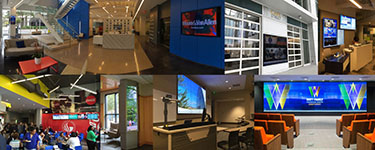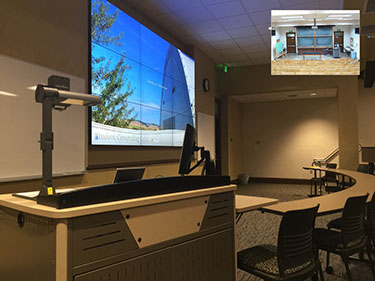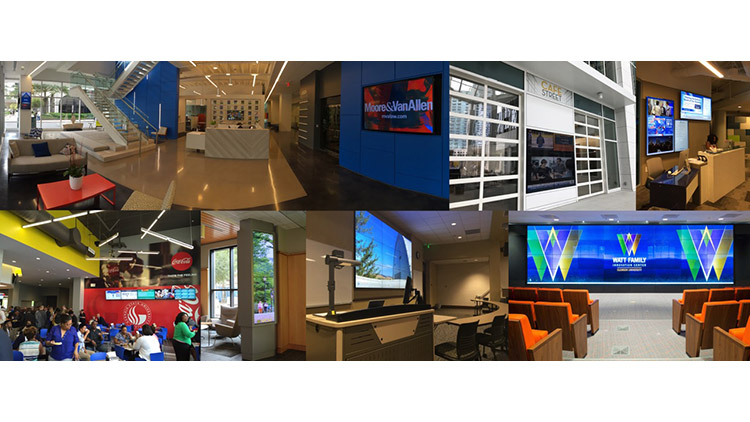For nearly 10 years Andrea Varrone, show director for the Digital Signage Expo (DSE), a trade show held every March in Las Vegas by event company Exponation, has witnessed the evolution of digital signage. “In the past, digital signage solutions required the use of extremely expensive and complicated hardware and software,” she said. With the onset of the cloud, things have changed dramatically, Varrone noted. “Gone are the days when you needed a content system, a networked managed server, player licenses, etc.” For some applications, “all that is required is a web browser and a player (or a smart screen), and you are off to the races.”

Networked digital signage has come of age. (Left to right) Projects from Visix Inc.: Charlotte Chamber of Commerce, Terminus Atlanta Cousins Properties, Georgia State University information desk, Georgia State University’s Piedmont central dining, Virginia Commonwealth University, University of Idaho (photo courtesy of LG), Clemson University Watt Family Innovation Center (photo Courtesy of Leyard and Planar).
This is not just about Millennials. Complete digital experiences are in demand among workers and students in every demographic. “The networked campus is becoming an expected perk in Silicon Valley and other tech hubs, and soon will be prevalent on all well-funded corporate, higher-ed and government campuses,” said Jeff Hastings, CEO of BrightSign. “The viewer’s expectation is for relevant information, engaging content and opportunities to interact with [digital] signage. They want to dig deeper and select their desired experience,” Hastings noted. “These high-end campuses attract people who desire quality experiences and expect the use of quality products to deliver them.”
Higher education is prime territory. “These venues are typically full ecosystems of their own, incorporating all that digital signage provides, wrapped up under one umbrella,” said Tiffany Dozier, executive vice president, Channel Sales at Premier Mounts. “There is wayfinding, classrooms, test labs, auditoriums, public areas, food service, dormitories, sports arenas, utilities, and security, all under a singular integrated campus information system.”
New display technologies combined with more sophisticated content delivery and management systems are delivering smarter experiences by using gathered data. “We see a number of recurring trends in the networked campus environment associated with new display technologies and data-driven content,” said Sean M. Matthews, President & CEO of Visix.
“Experiential designers in these markets may not have NBA budgets that allow marketers to virtually paint an arena floor with a reimagined visual experience, but they are doing a great job of using video walls, long, narrow displays, and flexible screens,” he said. “Building entrances are becoming more captivating with the use of cost effective video walls with timely, relevant content. Flexible displays and screens with narrow aspect ratios are being placed in locations that are creating more intriguing visual draws.”
Integrating Engaging Displays

A long overdue, high-tech makeover. The 120-person Life Sciences South 277 lecture hall at the University of Idaho is used primarily for critical biology, engineering, and science classes where class materials now include highly detailed and colorful images of cells, organisms, CAD drawings, diagrams, and charts. Nine 55-inch LG LV75A thin-bezel displays create a 3x3 video wall controlled and managed entirely through the lectern. The university can use the built-in diagnostics on the displays to monitor each individual panel’s output to make quick adjustments for optimal performance. CREDIT: Photo courtesy of LG
LG and other manufacturers are pushing the envelope by creating displays that fit the need in different environments, and among varied levels of engagement and experiences. At InfoComm 2017, LG demonstrated its Transparent LED Film, Ultra Stretch displays, dual-view OLED signage and wallpaper, and the show-stopping bending and moving OLED panels. “Implementing integrated systems can be a complicated process by which efficiency, engagement, and seamless management are really important,” said Clark Brown, vice president, digital signage, LG Electronics USA Business Solutions. “We recognize that today the needs of the end user are often much greater than one installation.”
When choosing a display for a particular installation, all factors need to be considered. “If you’re picking a display that will be secured outdoors at a restaurant, what capabilities are essential?” asked Ron Gazzola, senior vice president of Sales & Marketing IT B2B, at Samsung Electronics America. “You will need a solution with high brightness, perfect for great visibility outdoors in a drive-through,” he said. You will need an enclosure that makes the signage graffiti-proof and weather-proof so it is able withstand any harsh environment. “It’s also important that it has heating and cooling abilities for ever-changing outdoor temperatures.” In this scenario, the Samsung OH series offers customized solutions and remote content management enable through its SMART Signage Platform (SSP), and partner ecosystem. “In addition, these displays can also be serviced easily so there is not a lot of down time when they need to be tended to,” he noted.
As AV equipment gets smaller, it’s becoming more common to have equipment reside with the paired display. “Storage is a key consideration,” said Tony Caruso, product manager at Chief. “If you have a specific building on campus with 40 to 50 rooms, with products like CSPR, you can install the wall brackets ahead of time. At a separate location, you can preload all the equipment consistently across all the storage panels. When you do the install process, simply walk in the room with a prepopulated panel and slide it into place.”
Content is Still King
It’s hard to not look at those sexy display technologies and not make the decision to buy now. “An area of caution for someone who is thinking of deploying digital signage on a campus is to avoid picking all of the hardware ahead of time,” said Saundra Merollo, Senior Sales Engineer, Strategic Accounts, Sharp Imaging and Information Company of America. “Everyone starts out thinking they know what they want from digital signage and has a preconceived mental image. However, what is often forgotten is that hardware is secondary to content.”
There are enough failed digital signage deployments with dark screens to support Merollo’s case. “Content dictates which hardware you will use, as well as the environment it’s placed in, its orientation and the placement. Any time you are looking at a network campus deployment, I suggest that you first run a test trial in different areas of the campus to see which products work best and in which configuration for different areas,” she explained. “You also need to think about creating a scalable solution.” Sharp’s PN-Y Series professional LCD displays are a affordable, scalable and versatile. “While one solution might work well in the short term, it might be necessary to add additional features to it, such as an RSS feed or images and videos,” she said.
As technology managers and other staff charged with deploying “digital signage” become more involved in the overall process, new and overlapping applications are emerging. “The pervasiveness of digital signage continues to grow, and so does the opportunity to drive transformation,” said Kaitlin Murphy, Intel’s director of marketing for Business Client Platforms. “We’re creating a new way to use digital signage to collaborate. We’ve integrated Intel Unite, our collaboration solution for easy connections and content sharing, to digital signage displays. For areas like manufacturing, now employees can take over the screen and use it to host stand-up meetings and collaborate in real-time and when they’re done, the screen returns back to displaying its original company content. For us, it’s about optimizing digital signage to drive maximum value that goes beyond its traditional usages.”
When thought of as a complete ecosystem, integrated digital displays can be used more efficiently throughout an organization. “Simultaneously, campus communicators are more effectively integrating and presenting auto-updating content like event schedules, community calendars and social feeds to draw viewers into the real message they are trying to convey,” said Visix’s Matthews. “These data-driven content sources allow communicators to deliver a continuous stream of content that is timely and relevant without having to hire additional staff.”
“The focus on changing lobbies with these solutions are increasing opportunities for enhancing the brand, and for new ways to create impressions,” said Rich Ventura, vice president, Business Strategy at NEC Display.
IoT is the Digital Experience
The Internet of Things has accelerated every aspect of what was once known as only as digital signage. “Digital signage is the window to IoT,” said Samsung’s Gazzola. “From airports to transportation hubs to cinemas and arenas, digital signage is not only a branding initiative, but also a way that businesses can collect data analytics from customers. Samsung is committed to IoT and full connectivity by the year 2020, and digital signage is a huge part of that goal.”
Ultimately it is all about connectivity, creation, and dissemination of information, Premier Mounts’ Dozier added. “The objective is to provide useful data wherever you are, whenever you want it, and on any display device. The quality of the content and how seamless we make the interface will determine how much it is used and to what degree of success.” In the final analysis, no matter the venue digital signage “becomes a canvas to communicate messages to thousands of unique visitors each and every day," she said.
Cindy Davis is the producer of the AV/IT Leadership Summits and a contributing editor of AV Technology. Download the Tech Manager’s Guide to Networked Digital Signage: http://www.avnetwork.com/avnetwork/technology-managers-guide-to-networked-digital-signage/127436
INFO
avixa.org
brightsign.biz
chiefmfg.com
clemson.edu
digitalsignageexpo.net
exponation.net
gsu.edu
intel.com
lg.com/us/business
necdisplay.com
premiermounts.com
samsung.com/us/
sharpusa.com
uidaho.edu
visix.com
vcu.edu
digitalsignageexpo.net
exponation.net
intel.com
samsung.com
uidaho.edu

